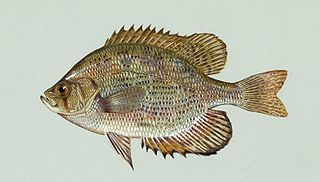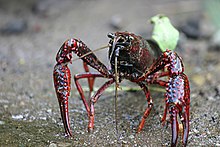
Crayfish are freshwater crustaceans belonging to the infraorder Astacidea, which also contains lobsters. Taxonomically, they are members of the superfamilies Astacoidea and Parastacoidea. They breathe through feather-like gills. Some species are found in brooks and streams, where fresh water is running, while others thrive in swamps, ditches, and paddy fields. Most crayfish cannot tolerate polluted water, although some species, such as Procambarus clarkii, are hardier. Crayfish feed on animals and plants, either living or decomposing, and detritus.

Centrarchidae, better known as sunfishes, is a family of freshwater ray-finned fish belonging to the order Centrarchiformes, native only to North America. There are eight universally included genera within the centrarchid family: Lepomis, Micropterus, Pomoxis (crappies), Enneacanthus, Centrarchus, Archoplites, Ambloplites, and Acantharchus. A genetic study in 2012 suggests that the highly distinct pygmy sunfishes of the genus Elassoma are also centrarchids.

Astacus is a genus of crayfish found in Europe, comprising three extant (living) species and three extinct fossil species.

Cambaroides japonicus, also known as Japanese crayfish, is a species of crayfish endemic to Japan.

Cambarus is a large and diverse genus of crayfish from the United States and Canada. The adults range in size from about 5 cm (2.0 in) up to approximately 15 cm (5.9 in).

Astacoidea is superfamily of freshwater crayfish that live in the Northern Hemisphere. The other superfamily of crayfish, Parastacoidea, lives in the Southern Hemisphere. Astacoidea consists of three families: Astacidae, Cambaridae, and Cambaroididae. Crayfish are closely related to lobsters, as shown in the simplified cladogram below:

Astacidea is an infraorder of decapod crustaceans including lobsters, crayfish, and their close relatives.

The Parastacidae are the family of freshwater crayfish found in the Southern Hemisphere. The family is a classic Gondwana-distributed taxon, with extant members in South America, Madagascar, Australia, New Zealand, and New Guinea, and extinct taxa also in Antarctica.

Cambaroides is a genus of freshwater crayfish from eastern Asia. Together with Pontastacus, they are the only crayfish native to Asia. Cambaroides contains about six species:

Astacidae is a family of freshwater crayfish native to Europe, western Asia and western North America. The family is made up of four extant (living) genera: The genera Astacus, Pontastacus, and Austropotamobius are all found throughout Europe and parts of western Asia, while Pacifastacus is native to western United States and British Columbia, but has also been introduced elsewhere.

Oncomelania is a genus of very small tropical freshwater snails, aquatic gastropod mollusks in the family Pomatiopsidae.

Austropotamobius is a genus of European crayfish in the family Astacidae. It contains four extant species,

Cambarellus diminutus is a species of crayfish in the family Cambaridae. It is endemic to the United States. It is native to Mississippi and Alabama, and is listed as Data Deficient on the IUCN Red List.

Procambarus is a genus of crayfish in the family Cambaridae, all native to North and Central America. It includes a number of troglobitic species, and the marbled crayfish (marmorkrebs), which is parthenogenetic. Originally described as a subgenus for four species, it now contains around 161 species.

Faxonius limosus, synonym Orconectes limosus, is a species of crayfish in the family Cambaridae. It is native to the east coast of North America, from Quebec to the lower James River, Virginia, but has also been introduced to Europe. It is known commonly as the spinycheek crayfish or Kamberkrebs in German.

The marbled crayfish or Marmorkrebs is a parthenogenetic crayfish that was discovered in the pet trade in Germany in 1995. Marbled crayfish are closely related to the "slough crayfish", Procambarus fallax, which is widely distributed across Florida. No natural populations of marbled crayfish are known. Information provided by one of the original pet traders as to where the marbled crayfish originated was deemed "totally confusing and unreliable". The informal name Marmorkrebs is German for "marbled crayfish".

Faxonius virilis is a species of crayfish known as the virile crayfish, northern crayfish,eastern crayfish, and lesser known as the lake crayfish or common crawfish. Faxonius virilis was reclassified in August 2017, and the genus was changed from Orconectes to Faxonius. It is native to the central United States, east to tributaries of Lake Erie, Lake Ontario, Lake Champlain and the St. Lawrence River in New York and to much of Canada.

Planocrania is an extinct genus of eusuchian crocodyliforms from what is now China. Two species are currently known to belong to the genus.
Aenigmastacus crandalli is a species of fossil freshwater crayfish. It was found in early Eocene Okanagan Highlands lake deposits in British Columbia, and was described in 2011. It is the first member of the Gondwana-distributed family Parastacidae to be found in the Northern Hemisphere, and is the only species in the genus Aenigmastacus. Twelve specimens are known, with a total body length of 3–5 cm (1.2–2.0 in). On some specimens, details of the internal anatomy can be seen due to the exceptional preservation.

Lacunicambarus is a genus of burrowing crayfishes in the family Cambaridae. There are currently 12 described species in Lacunicambarus, all of which are found east of the Continental Divide in North America. The genus was first recognized in 2018 when it was discovered through genetic analyses that the Cambarus subgenera Lacunicambarus and Tubericambarus were not monophyletic on their own, but that when combined they formed a single monophyletic group distinct from Cambarus. A 2022 study used anchored hybrid enrichment to resolve the Lacunicambarus phylogeny, which elucidated interspecific relationships and highlighted remaining undescribed diversity within the genus.


















